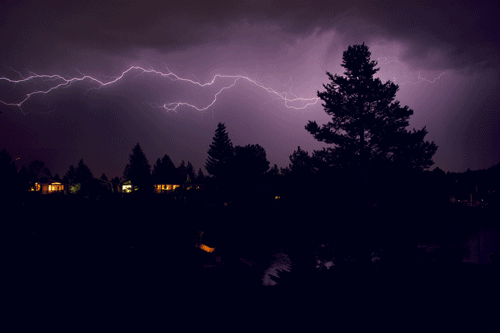A Giant Mosasaurus Patrolling The Prehistoric Seas.

A giant Mosasaurus patrolling the prehistoric seas.
More Posts from Starry-shores and Others
Ten interesting facts about Uranus
Like the classical planets, Uranus is visible to the naked eye, but it was never recognised as a planet by ancient observers because of its dimness and slow orbit. Sir William Herschel announced its discovery on 13 March 1781, expanding the known boundaries of the Solar System for the first time in history and making Uranus the first planet discovered with a telescope.

Uranus is the seventh planet from the Sun. It has the third-largest planetary radius and fourth-largest planetary mass in the Solar System. Uranus is similar in composition to Neptune, and both have different bulk chemical composition from that of the larger gas giants Jupiter and Saturn.

(The five largest moons of Uranus) Like all of the giant planets, Uranus has its share of moons. At present, astronomers have confirmed the existence of 27 natural satellites. But for the most part, these moons are small and irregular.

Uranus’ moons are named after characters created by William Shakespeare and Alexander Pope. These include Oberon, Titania and Miranda. All are frozen worlds with dark surfaces. Some are ice and rock mixtures. The most interesting Uranian moon is Miranda; it has ice canyons, terraces, and other strange-looking surface areas.

Only one spacecraft in the history of spaceflight has ever made a close approach to Uranus. NASA’s Voyager 2 conducted its closest approach to Uranus on January 24th, 1986, passing within 81,000 km of the cloud tops of Uranus. It took thousands of photographs of the gas/ice giant and its moons before speeding off towards its next target: Neptune.

Uranus has rings: All the gas and ice giants have their own ring systems, and Uranus’ is the second most dramatic set of rings in the Solar System.

Uranus makes one trip around the Sun every 84 Earth years. During some parts of its orbit one or the other of its poles point directly at the Sun and get about 42 years of direct sunlight. The rest of the time they are in darkness.
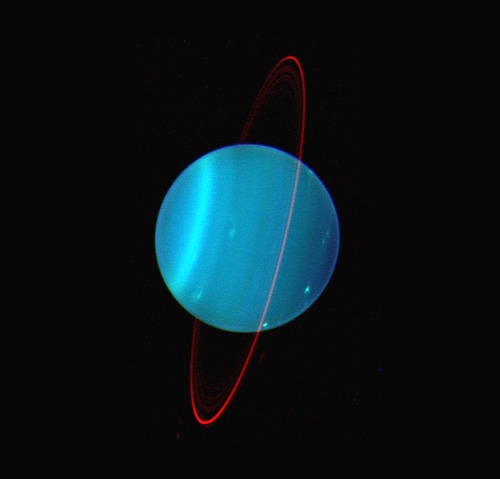
All of the planets in the Solar System rotate on their axis, with a tilt that’s similar to the Sun. In many cases, planet’s have an axial tilt, where one of their poles will be inclined slightly towards the Sun. But the axial tilt of Uranus is a staggering 98 degrees! In other words, the planet is rotating on its side.

Uranus is approximately 4 times the sizes of Earth and 63 times its volume.

Uranus is blue-green in color, the result of methane in its mostly hydrogen-helium atmosphere. The planet is often dubbed an ice giant, since 80 percent or more of its mass is made up of a fluid mix of water, methane, and ammonia ices.

Uranus hits the coldest temperatures of any planet. With minimum atmospheric temperature of -224°C Uranus is nearly coldest planet in the solar system. While Neptune doesn’t get as cold as Uranus it is on average colder. The upper atmosphere of Uranus is covered by a methane haze which hides the storms that take place in the cloud decks.
source
source
source
Images credit: NASA/ wikipedia
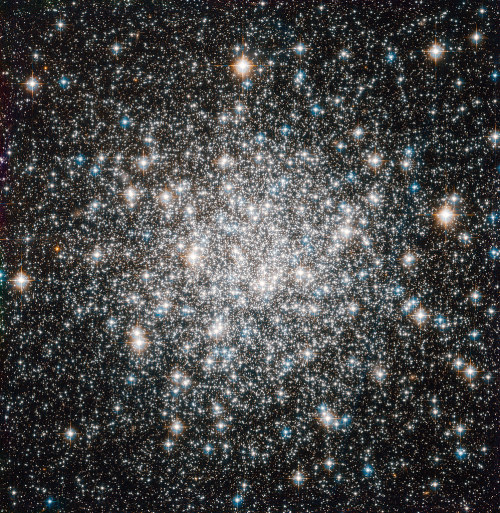
A ten billion-year stellar dance by europeanspaceagency
I’ve just made a behavioral study on birds (aka. I’ve fed bread to pigeons and crows) and I’d like to conserve the results for posterity:
Pigeons can and will fight each other for even the smallest crumb of bread
When a pigeon picked up a bread crumb and other pigeons are nearby it will spread its wings to ensure the other pigeons can’t get close enough to steal the crumb™
The other , bread stealing pigeons might also spread their wings to make sure that no pigeon can steal the breadcrumb before them
They will steal it straight from another pigeons beak
Pigeons have no manners
They WILL fly at you and hover around your head once they realized you’re the one throwing the crumbs
They have no concept of personal space.
Crows on the other hand are civilized.
They will try to get to the crumb first but when another crow has reached the crumb before them they will accept this and leave them be
However if a pigeon reaches the crumb first they WILL go absolutely feral and peck the pigeon until it surrenders the crumb
Pigeons are reasonably scared of crows and won’t try to steal crumbs from their very pointy stabby beaks
Crows will wait for you to throw the crumbs at an appropriate distance because they do have manners
Unlike pigeons they will also watch you and look right into your eyes, expectantly
If a crow looks at you , waiting, and you throw it a crumb it will try to catch it just like a dog would
Pigeons however don’t notice shit until it lies in front of their face or they see another pigeon found something
Crows understand pointing, pigeons don’t
If the crows are satisfied they will fly away
Pigeons are never satisfied and therefore will bother you until the very end (aka. Until you don’t have any bread left)
They always hunger.
In conclusion:
Feeding crows is more fun than feeding pigeons because crows know the rules of society and pigeons don’t.
(Next Time on “birdhavioral studies” : “why seagulls fear neither god nor devil” )
“The stars, like dust, encircle me In living mists of light; And all of space I seem to see In one vast burst of sight.”
—
Isaac Asimov

The Kepler space telescope has shown us our galaxy is teeming with planets — and other surprises

The Kepler space telescope has taught us there are so many planets out there, they outnumber even the stars. Here is a sample of these wondrous, weird and unexpected worlds (and other spectacular objects in space) that Kepler has spotted with its “eye” opened to the heavens.
Kepler has found that double sunsets really do exist.

Yes, Star Wars fans, the double sunset on Tatooine could really exist. Kepler discovered the first known planet around a double-star system, though Kepler-16b is probably a gas giant without a solid surface.
Kepler has gotten us closer to finding planets like Earth.

Nope. Kepler hasn’t found Earth 2.0, and that wasn’t the job it set out to do. But in its survey of hundreds of thousands of stars, Kepler found planets near in size to Earth orbiting at a distance where liquid water could pool on the surface. One of them, Kepler-62f, is about 40 percent bigger than Earth and is likely rocky. Is there life on any of them? We still have a lot more to learn.
This sizzling world is so hot iron would melt!

One of Kepler’s early discoveries was the small, scorched world of Kepler-10b. With a year that lasts less than an Earth day and density high enough to imply it’s probably made of iron and rock, this “lava world” gave us the first solid evidence of a rocky planet outside our solar system.
If it’s not an alien megastructure, what is this oddly fluctuating star?

When Kepler detected the oddly fluctuating light from “Tabby’s Star,” the internet lit up with speculation of an alien megastructure. Astronomers have concluded it’s probably an orbiting dust cloud.
Kepler caught this dead star cannibalizing its planet.

What happens when a solar system dies? Kepler discovered a white dwarf, the compact corpse of a star in the process of vaporizing a planet.
These Kepler planets are more than twice the age of our Sun!

The five small planets in Kepler-444 were born 11 billion years ago when our galaxy was in its youth. Imagine what these ancient planets look like after all that time?
Kepler found a supernova exploding at breakneck speed.

This premier planet hunter has also been watching stars explode. Kepler recorded a sped-up version of a supernova called a “fast-evolving luminescent transit” that reached its peak brightness at breakneck speed. It was caused by a star spewing out a dense shell of gas that lit up when hit with the shockwave from the blast.
* All images are artist illustrations.
Make sure to follow us on Tumblr for your regular dose of space: http://nasa.tumblr.com
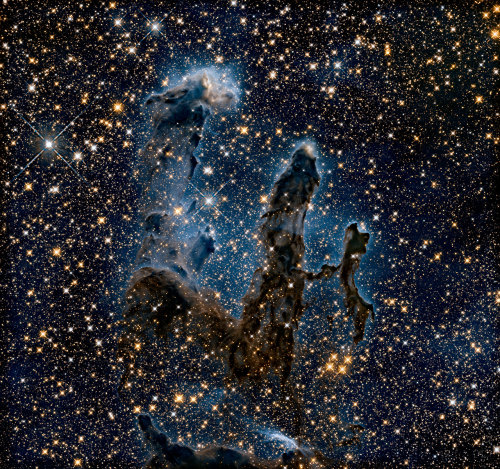
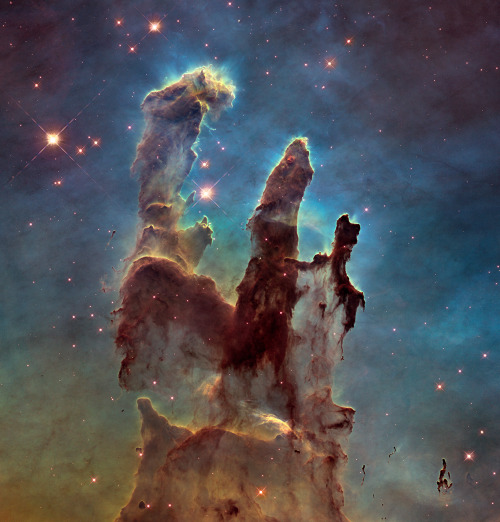
Sometimes… there’s more than meets the eye. 👀 You’re looking at two very different takes on an iconic image.
Human eyes can see only a small portion of the range of radiation given off by the objects around us. We call this wide array of radiation the electromagnetic spectrum, and the part we can see visible light.
In the first image, researchers revisited one of Hubble Space Telescope’s most popular sights: the Eagle Nebula’s Pillars of Creation. Here, the pillars are seen in infrared light, which pierces through obscuring dust and gas and unveil a more unfamiliar — but just as amazing — view of the pillars. The entire frame is peppered with bright stars and baby stars are revealed being formed within the pillars themselves. The image on the bottom is the pillars in visible light.
Image Credit: NASA, ESA/Hubble and the Hubble Heritage Team
Make sure to follow us on Tumblr for your regular dose of space: http://nasa.tumblr.com.
-
 dailycreature reblogged this · 1 year ago
dailycreature reblogged this · 1 year ago -
 greyselkie reblogged this · 2 years ago
greyselkie reblogged this · 2 years ago -
 greyselkie liked this · 2 years ago
greyselkie liked this · 2 years ago -
 scuuber-doober-diber reblogged this · 2 years ago
scuuber-doober-diber reblogged this · 2 years ago -
 flooferdoodles liked this · 2 years ago
flooferdoodles liked this · 2 years ago -
 potato-admires-art reblogged this · 3 years ago
potato-admires-art reblogged this · 3 years ago -
 musichenni133 reblogged this · 3 years ago
musichenni133 reblogged this · 3 years ago -
 ithelonelywolfblr reblogged this · 3 years ago
ithelonelywolfblr reblogged this · 3 years ago -
 ithelonelywolfblr liked this · 3 years ago
ithelonelywolfblr liked this · 3 years ago -
 mosa-nekojira liked this · 3 years ago
mosa-nekojira liked this · 3 years ago -
 sasha-is-dead liked this · 3 years ago
sasha-is-dead liked this · 3 years ago -
 zoe-porphyrogenete liked this · 3 years ago
zoe-porphyrogenete liked this · 3 years ago -
 batteredbatsy liked this · 3 years ago
batteredbatsy liked this · 3 years ago -
 la-bruba liked this · 3 years ago
la-bruba liked this · 3 years ago -
 naniya27 reblogged this · 3 years ago
naniya27 reblogged this · 3 years ago -
 naniya27 liked this · 3 years ago
naniya27 liked this · 3 years ago -
 wilde-woolf liked this · 3 years ago
wilde-woolf liked this · 3 years ago -
 decepticon17 liked this · 3 years ago
decepticon17 liked this · 3 years ago -
 b2thesecond liked this · 3 years ago
b2thesecond liked this · 3 years ago -
 ode-on-a-grecian-butt reblogged this · 3 years ago
ode-on-a-grecian-butt reblogged this · 3 years ago -
 ode-on-a-grecian-butt liked this · 3 years ago
ode-on-a-grecian-butt liked this · 3 years ago -
 miracinonyxtrumani reblogged this · 4 years ago
miracinonyxtrumani reblogged this · 4 years ago -
 mieps reblogged this · 4 years ago
mieps reblogged this · 4 years ago -
 mieps liked this · 4 years ago
mieps liked this · 4 years ago -
 rizu-not-risu liked this · 4 years ago
rizu-not-risu liked this · 4 years ago -
 oarfjsh reblogged this · 4 years ago
oarfjsh reblogged this · 4 years ago -
 itriedtoescape liked this · 4 years ago
itriedtoescape liked this · 4 years ago -
 starry-shores reblogged this · 4 years ago
starry-shores reblogged this · 4 years ago -
 an-abyss-called-life liked this · 4 years ago
an-abyss-called-life liked this · 4 years ago -
 weliketomoveit liked this · 4 years ago
weliketomoveit liked this · 4 years ago -
 bougonia liked this · 4 years ago
bougonia liked this · 4 years ago -
 impossiblekryptonitedreamland liked this · 4 years ago
impossiblekryptonitedreamland liked this · 4 years ago -
 korgsayspissoffghost reblogged this · 4 years ago
korgsayspissoffghost reblogged this · 4 years ago -
 sybungo reblogged this · 4 years ago
sybungo reblogged this · 4 years ago -
 maebehappy liked this · 4 years ago
maebehappy liked this · 4 years ago -
 persephone203 liked this · 4 years ago
persephone203 liked this · 4 years ago -
 twyxted-mind liked this · 4 years ago
twyxted-mind liked this · 4 years ago -
 steinbit reblogged this · 4 years ago
steinbit reblogged this · 4 years ago -
 kasperl-ruprecht reblogged this · 4 years ago
kasperl-ruprecht reblogged this · 4 years ago -
 unalived-satanist-blog liked this · 4 years ago
unalived-satanist-blog liked this · 4 years ago -
 throat-eater liked this · 4 years ago
throat-eater liked this · 4 years ago -
 moorwood reblogged this · 4 years ago
moorwood reblogged this · 4 years ago -
 oddlyautumnal-moved liked this · 4 years ago
oddlyautumnal-moved liked this · 4 years ago -
 extra-mt16 reblogged this · 4 years ago
extra-mt16 reblogged this · 4 years ago -
 kasperl-ruprecht liked this · 4 years ago
kasperl-ruprecht liked this · 4 years ago -
 sea-boi reblogged this · 4 years ago
sea-boi reblogged this · 4 years ago

Amateur astronomer, owns a telescope. This is a side blog to satiate my science-y cravings! I haven't yet mustered the courage to put up my personal astro-stuff here. Main blog : @an-abyss-called-life
212 posts




